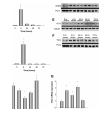Staphylococcus aureus sepsis and mitochondrial accrual of the 8-oxoguanine DNA glycosylase DNA repair enzyme in mice
- PMID: 20732986
- PMCID: PMC3040391
- DOI: 10.1164/rccm.200911-1709OC
Staphylococcus aureus sepsis and mitochondrial accrual of the 8-oxoguanine DNA glycosylase DNA repair enzyme in mice
Abstract
Rationale: Damage to mitochondrial DNA (mtDNA) by the production of reactive oxygen species during inflammatory states, such as sepsis, is repaired by poorly understood mechanisms.
Objectives: To test the hypothesis that the DNA repair enzyme, 8-oxoguanine DNA glycosylase (OGG1), contributes to mtDNA repair in sepsis.
Methods: Using a well-characterized mouse model of Staphylococcus aureus sepsis, we analyzed molecular markers for mitochondrial biogenesis and OGG1 translocation into liver mitochondria as well as OGG1 mRNA expression at 0, 24, 48, and 72 hours after infection. The effects of OGG1 RNA silencing on mtDNA content were determined in control, tumor necrosis factor-α, and peptidoglycan-exposed rat hepatoma cells. Based on in situ analysis of the OGG1 promoter region, chromatin immunoprecipitation assays were performed for nuclear respiratory factor (NRF)-1 and NRF-2α GA-binding protein (GABP) binding to the promoter of OGG1.
Measurements and main results: Mice infected with 10(7) cfu S. aureus intraperitoneally demonstrated hepatic oxidative mtDNA damage and significantly lower hepatic mtDNA content as well as increased mitochondrial OGG1 protein and enzyme activity compared with control mice. The infection also caused increases in hepatic OGG1 transcript levels and NRF-1 and NRF-2α transcript and protein levels. A bioinformatics analysis of the Ogg1 gene locus identified several promoter sites containing NRF-1 and NRF-2α DNA binding motifs, and chromatin immunoprecipitation assays confirmed in situ binding of both transcription factors to the Ogg1 promoter within 24 hours of infection.
Conclusions: These studies identify OGG1 as an early mitochondrial response protein during sepsis under regulation by the NRF-1 and NRF-2α transcription factors that regulate mitochondrial biogenesis.
Figures






References
-
- Angus DC, Linde-Zwirble WT, Lidicker J, Clermont G, Carcillo J, Pinsky MR. Epidemiology of severe sepsis in the United States: analysis of incidence, outcome, and associated costs of care. Crit Care Med 2001;29:1303–1310. - PubMed
-
- Hamilton BE, Minino AM, Martin JA, Kochanek KD, Strobino DM, Guyer B. Annual summary of vital statistics: 2005. Pediatrics 2007;119:345–360. - PubMed
-
- Raha S, Robinson BH. Mitochondria, oxygen free radicals, disease and ageing. Trends Biochem Sci 2000;25:502–508. - PubMed
-
- Taylor DE, Kantrow SP, Piantadosi CA. Mitochondrial respiration after sepsis and prolonged hypoxia. Am J Physiol 1998;275:L139–L144. - PubMed
Publication types
MeSH terms
Substances
Grants and funding
LinkOut - more resources
Full Text Sources
Medical
Research Materials

